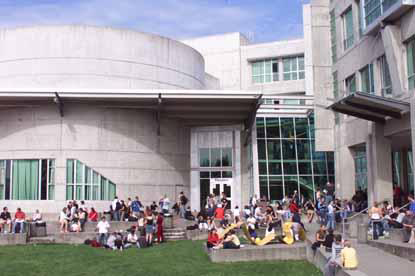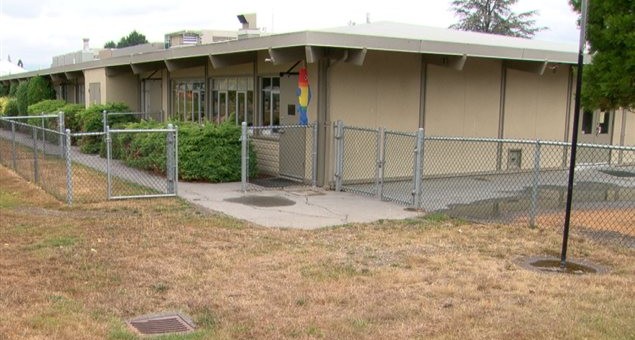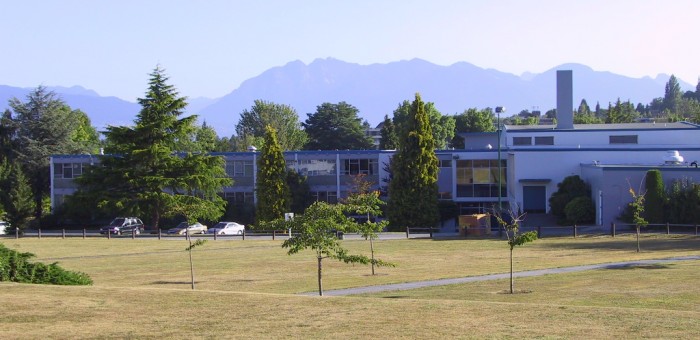K-12 Education
Comments on Vancouver School Board Firing
For immediate release
Oct. 17, 2016
Weaver Comments on Vancouver School Board Firing
Victoria, B.C. – “For public education to thrive in British Columbia, the provincial government must work effectively and in partnership with Boards of Education to put students first,” said Andrew Weaver, leader of the B.C. Green Party and MLA for Oak Bay-Gordon Head. “Minister Bernier’s announcement today is yet another example of how the dysfunctional relationship between the B.C. Liberals and Boards of Education results in the spending of more time and money on opposing each other than on finding solutions that will benefit students and teachers in the classroom.”
“We need to build relationships that establish trust. Education in B.C. needs a fresh start. The B.C. Greens are committed to working collectively with all stakeholders to make public education a priority and put the interests of BC students first.”
“With the cancelling of the fall Legislative session, this major decision was made without parliamentary oversight, allowing the B.C. Liberals to avoid being held accountable for their continued mismanagement of our public education system.”
– 30 –
Media contact
Mat Wright
Press Secretary
Office of Andrew Weaver, MLA
+1 250-216-3382
2nd Reading of Bill 23: Sexual Violence and Misconduct Policy Act
Today in the Legislature was second reading of Bill 23: Sexual Violence and Misconduct Policy Act, 2016. As promised by the Premier, this legislation was introduced by government in response to my private members Bill M205: Post-Secondary Sexual Violence Policies Act.
This bill, based on similar legislation in Ontario, was designed to address the pervasive occurrence of sexualized violence plaguing universities, colleges and other post-secondary institutions in British Columbia. If enacted, it would create a legal responsibility for them to develop and maintain policies that would work to prevent the occurrences of sexual violence and provide support for survivors. The act would allow university- and college-specific policies to be developed that would meet the needs of students, including education and protection, while working to create a safe environment for all students to come forward to report a sexual assault.
Below are the text and video of my second reading speech.
Text of Speech
It gives me great pleasure to rise and speak in support of Bill 23, the Sexual Violence and Misconduct Policy Act. As we know, this bill arose in response to an earlier private member’s bill which was submitted to this House. It represents the cumulative input from numerous stakeholders across the province and is ultimately based on similar legislation that was tabled and passed in Ontario, catered slightly to the needs of British Columbia post-secondary institutions.
There were some changes in this act as brought forward, as mentioned by the official opposition, from the earlier version, including, for example, the focus on public post-secondary institutions, no longer including some of the private institutions. I have had discussions with the minister about the intention of this, and I’m sure we’ll explore that further as the minister is posed questions during committee stage.
There’s also, of course, the issue of gender identity and gender expression which, I have argued quite strongly, is important given that the transgender community experience sexualized violence and misconduct at even a greater extent than do women in our society. So we need this to be inclusive. But again, government will respond at the committee stage with reasons and rationale for the language that we have here.
In addition, there has been a comment made that the word “sexual violence,” under the definitions, was changed to “sexual misconduct.” In the original version, it had “sexual violence.” I recognize that for some people that might be troubling. What, to me, was very important is that the words “sexual violence” still appear in the title. Under the definitions, it is a definition meaning sexual misconduct.
I recognize that for many…. Including the original version I put in, sexual violence was used there. However, because it is a definition, what it is saying is anything within the quotes, wherever it follows in the legislation. Whether it be the words “sexual violence” or “sexual misconduct,” it doesn’t matter. What matters is that wherever you see those two words, it is defined by sexual assault, sexual exploitation, sexual harassment, stalking, indecent exposure, voyeurism, etc.
This bill was the culmination of many, many hours of engagement with students, faculty associations, support services for survivors, and others. We had a town hall on this bill, just last week, attended by quite a large number of University of Victoria students. It was put on in collaboration with the University of Victoria Students Society. It was also attended by representatives from a number of agencies in and around Victoria. I will say that the overwhelming majority — in fact, in its entirety — there very strong support within the student body for the work that’s represented in this bill.
Now, what is it that this bill is trying to address? Let me see if I can provide some very illustrative examples of the type of things that occur.
There was a very unfortunate, in my view, editorial in the Times Colonist, which missed the point of this bill. In the Times Colonist recently, they talked about the fact that this should simply be a matter to be dealt with by the police. Of course we recognize that when criminal charges are to be laid, the police must be involved. Universities, post-secondary institutions, colleges, do not — do not — file charges and take people to court in a criminal sense. That is the role of the police.
However, that is not the issue. The issue is the systemic prevalence of sexualized violence on university and post-secondary campuses. I’m going to give you a few examples, but it comes to a much broader issue. While some might say that it’s always been around, it has always been around.
Fundamentally, we have in our society an entire generation of youth who’ve been brought up in the Internet age, where the accidental type of typing in a woman’s name can lead you to websites that put forward images of sexualized violence at the click of a finger, the push of a button. A whole generation of youth are exposed to graphic images, such that I begin to worry whether or not many within our society understand what a healthy relationship is. A healthy relationship is often — more often than not, certainly most often than not — expressed in some of the imagery that one can see on the internet so easily, and so difficult to control.
This is not something that existed during my time as a student university or as a grad student. Of course there has been and continues to be sexualized violence on campuses, both past and present. While our goal is to eliminate it in the future, we will do our best, but there will always be cases. No case is acceptable, and we must work towards zero cases.
However, there is a difference. The exposure to the Internet and exposure to the type of behavior that is highly graphic, highly offensive to many — to most, to all — that in more cases than not demonstrates a very unhealthy relationship between a man and a woman or between two people of the same gender.
It is unhealthy, yet we have a generation of youth exposed to this, entering to post-secondary institutions where, for the first time, they are moving away from home. They may be living in close quarters with others. Where for many, the concept of consent has never been discussed.
I’ll come to that later, when we talk about the movement of policies like this into the K-to-12 sector and the work that we’ve been doing to try to engage students in that regard. But let me give a couple specific examples, without quoting universities, without quoting colleges. I will say that in many cases, what I’m going to say as an example happened at multiple universities.
Here’s one. Let’s suppose, hypothetically…. Well, this is a true case, so we don’t need to suppose hypothetically. In at least two universities, there are cases where a very serious sexual assault occurred in student residences. Now, the difficulty with that is that student residences are places where people have to live beside each other.
If a serious sexual assault occurs in a residence, obviously, you would like to get the people away from each other. In at least two cases, that didn’t happen. The survivor had to live in the same dormitory as the perpetrator of the assault because of the inaction of an institution. That’s unacceptable. That’s unacceptable that an institution would cave to the legal threat of the perpetrator that they would sue if they were kicked out of residence. There needs to be policy that allows institutions to do that so that they’re not afraid to put the survivor first and to deal with the matters that are appropriate.
Here’s another story, a story that occurred in many places. This is a story about a very bold survivor named Jean Strong at Thompson Rivers University, who was quite forthcoming with us, participated in our panel last week and who went to Thompson Rivers University. Jean Strong was sexually assaulted twice in one term on campus. The psychological effects were profound, yet this student had to be on campus and attend the same classes as the perpetrators.
When going to the administration, she was told that perhaps the institution was not the best for her and that they would help her fill out forms to apply to another university in British Columbia and elsewhere in Canada. Now, that’s clearly not an acceptable response. And when the bold survivor, Jean Strong, told her story, what happened? More students came out and expressed their concern to Jean, who became like a flag-bearer for this issue on the campus.
I’ll give you another story. This is a story about Capilano University and a professor who, in their class, discussed the introduction of this bill. The reason why the professor wanted to discuss the introduction of this bill is because the official reporting stats from Capilano were that there were zero cases of sexualized violence on the campus. When the professor raised this to the class and discussed this bill to talk about the issue, one young woman in the class ran outside of the classroom, quite upset. And why was that the case? Well, as you might imagine, there were not zero cases of sexualized violence that occurred in the Capilano University environment.
I could go on with other examples — cases where people were told that in fact because they didn’t say no, then, really, the university or institution cannot do anything. It’s a fundamental misunderstanding of what consent means. Consent does not mean saying no or not saying no. Consent means specifically saying yes, which seems to be missed in the several cases that we’ve heard.
I’ve had cases come to me of international students who felt lost that the institutions had not looked after them, and they don’t know where to go. They don’t know what the services are, and they were hoping to get some support — and in some cases, didn’t. The litany of stories that we got from across British Columbia was overwhelming. And it was not only across British Columbia; they started coming in from across Canada. This is an issue that’s not exclusive to one university, not exclusive to one college. It’s pervasive across North America, and it says that there is something very wrong in our society — something very wrong when this sort of behavior can actually go on, on campuses and a lid be put over it.
One of the themes that came up at the town hall we had last week — it was actually quite an interesting theme — was that there was a concern expressed by more than one individual that the growth of the concern on campuses about the suppression, the perceived suppression, of actions on sexualized policy came lock in step with the corporatization of some of our university and post-secondary institutions — perhaps less of an issue to some of the smaller institutions, but more an issue to some of the bigger ones. Universities must and need to be perceived as safe places for students, not only local but across the world — safe places for those students to learn, to innovate, to be creative and to contribute to research and understanding of everything around us.
Universities, colleges and post-secondary institutions spend a lot of time trying to brand their university, to have a corporate brand on it. Now, the last thing you want is a corporate brand that actually gets undermined by the kind of outpouring of concern that we’ve seen, for example, happening on some of our university campuses of late. We have had examples from UBC. We’ve had examples from Thompson Rivers, which I mentioned, and elsewhere too. This is not good for the corporate branding of an institution.
There’s an inherent, built-in wish — whether acted upon or otherwise — that these issues not blow up, because it doesn’t do a good thing for one’s branding. Hence, some of the concern that in fact a lot of the concerns are being brushed under the table on our university campuses.
My hope and goal is that this will actually go beyond university campuses. As I’ve alluded to earlier, some of the problems are that university campuses…. Post-secondary institution campuses are really the first place where young people today move away from home, have constraints and barriers removed from them and are living away, perhaps in close quarters in dorms. They’ve grown up in an age of unrestricted access, on the Internet, to videos, to images that actually portray relationships in very unhealthy ways. Many may not understand what is or is not a healthy relationship. So we need to get education happening in the K to 12 as well.
In fact, I was in a Vic High class two weeks ago, with a teacher there. There’s actually a project that was initiated by a group called B.C. Speaks, which is a citizens’ assembly pilot project. What they did is they went and worked with Jim Pine, an outstanding socials teacher at Vic High, who’s in their 12 grade social justice class. They picked up the issue of sexualized violence, and they wanted to understand how the curriculum in British Columbia could be modified or changed to actually incorporate this in the K-to-12 sector.
These are the key points that this amazing class of individuals came up with. They recognized that key issues, like incorporating consent in the curriculum, are important. The term “consent” does not appear anywhere in the new sexual education curriculum that’s being discussed now. They want to emphasize respect. Sexual education is more than learning about body parts and sexual intercourse. It’s about learning to be a good person and to treat others with respect.
They want more time spent, to increase the time spent on sexual education. Eighty minutes per grade is too small an amount to deal with all complexities of this topic. Many questions are left unanswered, they say, or are informed by poor sources, such as the Internet pornography that I have referred to earlier. They’re hoping to see sex education curriculum for grades 11 and 12, as there is none in the grade 11 and 12 curriculum. They’re hoping to see a new course on human well-being being introduced. The course would deal with sexual, emotional, physical and mental well-being. It would be mandatory, they would argue.
Now, I have some sympathy for this. All students are taking a course called “Grad Transitions,” and I can think of no better course to actually embed the important issue of what is or is not a healthy relationship and what is or is not consent than in a course that all students must take.
They point out that there’s inadequate sex ed in grade levels, which leads to poor behaviour at universities and beyond, something that I have great sympathy for. They went so far, as I alluded to, as to actually develop some suggested curricula. We are in good hands when the next generation recognizes that there is an issue in our society for which solutions exist and they’re willing to stand up and be part of forming those solutions and disseminating them through others.
Let’s come back to the bill. We sought, in the earlier version that I introduced as a private member’s bill, input from every university student society in the province as well as input from support services for survivors, and we got an enormous number of responses — let me say, overwhelming support for this bill. Without question, there was no person, no group that responded that we don’t need this bill.
There were some institutions that would argue that they’re further along the advancement towards the development of such policies and look forward to tweaking their policies to bring them in line with others. And there were some who felt that there was a desperate urge and need for policies to be brought in.
If we go to BCIT, for example, we had a number of comments from there. They actually have a student code of conduct, non-academic conduct, which states the following.
“BCIT’s Student Code of Conduct applies to conduct that occurs on BCIT premises, at BCIT-sponsored activities and to off-campus conduct that has the potential to adversely affect the institute, community and/or the pursuit of BCIT’s objectives. The policy is applicable to students as well as other individuals while they are on BCIT premises or in attendance at BCIT-authorized or BCIT-sponsored functions.“
Now, this is important, because there are two things that they start to talk about in this code of conduct. We’re not specifically talking about sexualized violence, but they actually raise the concept of a code of conduct, and in their comments, they raise the concern that we need to ensure that more people are included other than just university students, a point that was also brought forward by the University of British Columbia. It is talking now about university faculty-student or staff-to-staff or staff-to-faculty or staff-to-student relationships and the role of sexualized violence in poisoning some of these relationships on campuses across the province.
With that said, one of the good things here with the legislation is it does allow for this. It doesn’t prescribe only students. In fact, it prescribes some language called “prescribed persons.” That is, regulations will allow for others to be included in this legislation, such as faculty, such as staff, bringing this concept broader, integrating it fully within the university community.
The code of conduct within the BCIT also states:
“Each student will be responsible and accountable for his or her conduct from the time of application for admission or enrolment through the actual awarding of a credential. This includes but is not limited to conduct that may occur in the following times and situations: during the academic year; before classes begin or after classes end; during periods between terms of actual enrolment; during periods when the student may be completing a practicum or work term for an employer or other organization, either for compensation or not, when required by a program of study at BCIT; during a time when a student withdraws from the institution while a disciplinary matter is pending; conduct that is not discovered until after a credential has been awarded.“
This is a rather broad student code of conduct that exists at BCIT in terms of the time at which it applies. This is one of the things that the BCIT folk we talked to suggested was important, recognizing in the development of policies that the time at which these policies applied must be broad, and they’ve offered some suggestions here as well. We had a number of comments, as I mentioned, from BCIT.
We had extensive feedback from a nine-member panel, a multi-stakeholder group called the sexual assault prevention and response working group. They were, overall, quite supportive of the legislation. They had a couple of things that they thought might need some clarity. They thought that more clarity was needed regarding the scope of application of the legislation.
As I’ve discussed earlier, there was some concern about the survey. That is, they had a number of concerns related to this. They were concerned when it comes to collecting and reporting data. They were concerned about lumping together incidents of sexualized violence that, broadly defined, could mischaracterize the nature and scope of the issues, as well as potentially trivialize the seriousness of the more serious.
In essence, what they were saying is that the data needs to be quality data. We don’t want to have lots of reporting data that inflate statistics or multiply report the same statistic or diminish the importance of more serious cases over some cases that may be slightly less serious. They outlined in their detailed and thorough response to us quite a number of recommendations with respect to that.
Of course, the concerns about confidentiality were first and foremost — we do have the privacy legislation here in British Columbia. There’s concern expressed, by numbers, and I’m sure the government would agree with this — that the concern for the privacy of the survivor and also the alleged perpetrator be protected at all times during this process.
We had extensive feedback from UBC, talking about the requirement for policy, specifically talking about the needs for staff and faculty to be involved, the need to have very broad consultation and to increase the consultation beyond just students, to include First Nations students, as well as transgender students and people representing a diversity of our society.
This is very solid advice that I think we should act upon and that I think is the intent of this legislation. Most university campuses attempt to be inclusive in their consultative process. What the UBC group that we talked about there were hoping to ensure is that this is actually part of the intent of the legislation and be made aware. These are the things we’ll explore during committee stage.
We had some comments from, as I mentioned, survivors services. We had some comments from the Canadian Federation of Students, from an anti-violence project, on one campus, and from the Native Students Union at the University of Victoria. Again, this is one of a unique, rather large group at University of Victoria, the student union there, who were concerned about the treatment of First Nations and the means and ways the process includes them, and the fact that — they would argue, then, and the evidence is borne out — there is an increased risk of sexualized violence amongst First Nations students.
We had, again, many, many suggested amendments. We had comments from staff. We had the Capilano Faculty Association formally pass a resolution supporting the private member’s bill. I won’t tire Hansard staff by listing all the multitude of people that we were discussing with and we continue to discuss with.
There were some more concerns out of UBC. This was important. Not concerns we received from consultation with people from the University of British Columbia. There was concern that a problem that needs to be clearly identified is that the present legislation has no requirements for universities to acknowledge their own liability. One of the things that’s important about this legislation is that the sheer fact it exists means that there will have to be an education component.
One of the ways that universities and colleges can deal with ensuring that people understand the existence of these policies is to go to their orientation weeks. Every new student who is going to these new post-secondary institutions typically participates in orientation weeks, and it is in the orientation weeks that the education component of the introduction of this bill could start to talk about the issue of what consent is.
Consent is not saying: “Oh, the person didn’t say no. Therefore, I have consent.” Consent is about specific statement of yes. Consent is not about not saying no; it’s about saying yes. We need talk about what a healthy relationship is, talk about what is expected or not expected behavior in a dormitory on campus. These types of things need to be and will be included as various institutions across British Columbia move forward with the development of their policies.
Another problem that has arisen was the following rights for individual students should be required in the legislation. Now, some of these are implicit in the actual existence of privacy laws within B.C., but the specific ones that they talk about here are explicit steps to ensure an individual’s right to privacy, due process, equally of both accused and victim. And the prohibition of silencing. These I think are key points that, again, we can explore as we discuss the bill further at committee stage.
Again, another problem. This is with respect to section 5, regarding the survey. This is recent feedback we have got not only on the government’s bill but also on the prior version of that via the private member’s bill.
It said: “As written, this introduces political decision-making, the infrequent discretion of the Minister of Education, into what should be an annual fact-investigation process which allows standardized comparison against all institutions of higher learning in British Columbia.” It’s an important point. I’d be delighted to share some of this feedback with the minister or at committee stage where we can actually flesh out where these concerns are coming from.
That’s not to say that this bill is not supported. It was wholeheartedly supported. But it’s important that we reflect upon the various comments and concerns that were raised as we move forward in the development of the required policies.
Another good point that was raised, coming out of the UBC cases that we were talking about, is that the legislation does not require institutions to warn about ongoing possible threats; regularly disclose the number of expelled students, fired employees, and ongoing investigations; or specifically collecting and publishing statistics about incidents.
The issue of ongoing threats is an important one. There have been documented cases, high-profile cases, in British Columbia where known perpetrators — known to institutions — have gone on and subsequently been involved with sexualized violence with other survivors on campuses. The institution knew of existing examples. This is important — that there be some requirement for institutions to warn about possible threats within their community.
There are other issues there were raised here with respect to the employee-student relationships. A very important one, of course, is that in an employee-student relationship, there is a power over. That can be abused. Recommendations we received in that area were quite common.
We have another series of 44 recommendations that actually came from some legal advice we received that would actually also be very helpful in the formulation of policies across campuses that we will make available subject to approval from the people who sent it to us.
There is great interest in this bill across British Columbia. There is great desire for this bill to pass across British Columbia. This bill, like every bill, will not be perfect. It will need to be reviewed and evolved as time goes on, as society changes.
It does point out the need, from the feedback we got, for complementary legislation to start to emerge for the K-to-12 sector, particularly in dealing with the fact that students are now graduating in an age where times have changed, given the preponderance of availability of the Internet and all the good and bad that happens with that.
With that, I thoroughly look forward to discussing this bill further at committee stage. I’m sincerely grateful to the many survivors across this province, to the student associations across this province, to the faculty associations across this province, to the hard-working people at the survivor centres across this province and to the Minister of Advanced Education and the government for their work towards making this act a reality.
It came. It was a lot of hard work — a lot of people involved. But first and foremost, we must thank those who’ve had bold courage to actually stand up and speak out.
Video of Speech
Should we Lower the Voting Age to 16? What do you think?
Background
One of the fundamental issues that motivated me to get into politics was that in my view, far too many of our political leaders are shortsighted in their decision-making. That is, too often political opportunism and the quest for re-election are the determining factors and primary motivators in a prevailing short-sighted and short-term political agenda. But that does not serve society well in the long run.
Let me give you three concrete examples.
- Recently, our premier suggested that the solution to the underfunding of public education lay with growing the economy. Fundamentally the B.C. Liberals have it backwards. A quality education is not the luxury of a strong economy. A quality public-education system is what builds a strong economy. Our society has thrived through innovation precisely because of the emphasis we have placed on education. The doctors, engineers, nurses and skilled labour of tomorrow — those who will take care of us as we age — are in the school system today. Surely it’s in all of our long term interests to ensure substantive short term investment in the society of tomorrow.
 We’ve all heard of the Dr. Suess book The Lorax, in which the Once-ler destroys the Truffula forest in a short-sighted quest to produce Thneed garments (“A-fine-something-that-all-people need”). In the end, with the forest gone, the Once-ler’s wealth and prosperity collapses and he lives a depressed life of solitude. The Lorax, published in 1971, beautifully articulates the result of short-sighted and unsustainable resource management. A Loraxian approach to resource management does not protect our renewable resources, natural environment or build public support. Yet this is the approach we are far too often taking in British Columbia, or frankly more broadly in Canada as a whole. It’s a bit like being given a great big inheritance, using that inheritance to throw a huge party, and then waking up the next day broke, with a wicked hangover and asking oneself “Now What?”.
We’ve all heard of the Dr. Suess book The Lorax, in which the Once-ler destroys the Truffula forest in a short-sighted quest to produce Thneed garments (“A-fine-something-that-all-people need”). In the end, with the forest gone, the Once-ler’s wealth and prosperity collapses and he lives a depressed life of solitude. The Lorax, published in 1971, beautifully articulates the result of short-sighted and unsustainable resource management. A Loraxian approach to resource management does not protect our renewable resources, natural environment or build public support. Yet this is the approach we are far too often taking in British Columbia, or frankly more broadly in Canada as a whole. It’s a bit like being given a great big inheritance, using that inheritance to throw a huge party, and then waking up the next day broke, with a wicked hangover and asking oneself “Now What?”.- Right now, it is in every person, in every household, in every municipality, in every city, in every province, in every country in the world’s best interest to do precisely nothing about global warming from a traditional cost-benefit point of view. That is because the costs of action are borne by the individual and the costs of inaction are distributed over 7 billion people in the next generation. Global warming is literally a textbook example of the Tragedy of the Commons with the atmosphere being the shared natural resource.The decisions we make today as to whether or not we put an increasing price on emissions will have profound consequences on the climate, natural and built environment, biodiversity and availability of water over the next century. Yet those making the decisions today will not have to live the consequences of the decisions they are making.
To summarize, most of the grand challenges of our time require decision-makers to look beyond the next election cycle and instead reflect upon the long-term consequences of their decisions. Dealing with poverty, homelessness and the increasing income disparity between the wealthy and the poor, or sustainable resource development, global warming and other environmental issues, or envisioning ways and means of moving towards more steady-state, diversified economies that aren’t subject to wild boom and bust cycles all require us to reflect upon the importance of intergenerational equity. This leads me to pose the following question:
Should the present generation also consider future generations in
the fiscal, social and environmental decisions we make?
I happen to think we do.
Yet herein lies the fundamental problem. Today’s decision-makers don’t have to live the long-term consequences of the decisions they make and those who do are either not allowed to, or are not participating in, our democratic institutions.
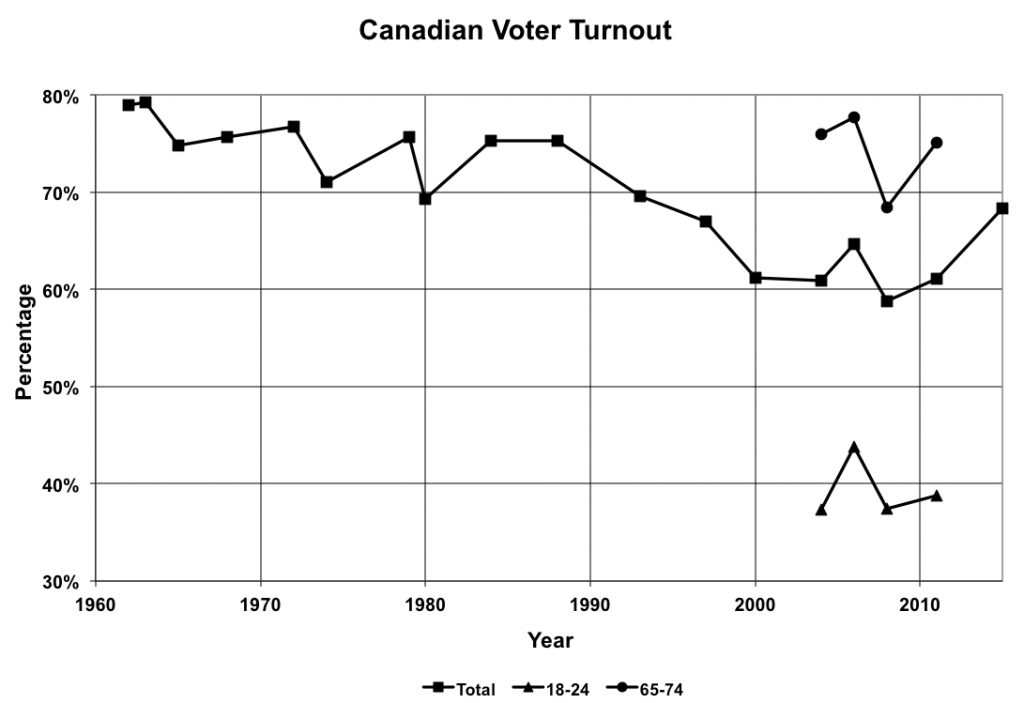 As shown in the figure above, upwards of 70% of seniors over the age of 65 have voted in our recent federal elections. Only around 40% of youth between the ages of 18-24 voted (age-related demographic data likely won’t be available until May for the 2015 federal election). Is it any surprise that many of our political leaders target their promises and messaging to a demographic that they know will vote. I’d wager that when the results become available, we’ll see that the youth participation rose in the 2015 election as it was clear that Prime Minister Trudeau and his Liberal team were discussing values that mattered to the youth of today.
As shown in the figure above, upwards of 70% of seniors over the age of 65 have voted in our recent federal elections. Only around 40% of youth between the ages of 18-24 voted (age-related demographic data likely won’t be available until May for the 2015 federal election). Is it any surprise that many of our political leaders target their promises and messaging to a demographic that they know will vote. I’d wager that when the results become available, we’ll see that the youth participation rose in the 2015 election as it was clear that Prime Minister Trudeau and his Liberal team were discussing values that mattered to the youth of today.
Voting Age History
The voting age was not always 18 in British Columbia and Canada. In fact, it wasn’t until 1970 that the Canada Elections Act was amended to drop the voting age from 21 to 18. In British Columbia we made the jump in two steps. First, in 1952 we dropped the voting age from 21 to 19, but it wasn’t until 1992 that we made the subsequent change to lower the age to 18.
 Around the world more and more jurisdictions are openly discussing the notion of dropping the voting age to 16. In fact, a growing number have actually done so. The most recent and notable example of this occurred in Scotland.
Around the world more and more jurisdictions are openly discussing the notion of dropping the voting age to 16. In fact, a growing number have actually done so. The most recent and notable example of this occurred in Scotland.
Scotland experimented by lowering the voting age in their September 18, 2014 independence referendum. They viewed it as being so successful that they subsequently permanently dropped the voting age to 16 in all future Scottish Parliament and local government elections.
The voting age in Brazil has been 16 since 1988; Austria changed its voting age to 16 in 2007; Argentina dropped the voting age to 16 in 2012. These are but a few of the growing number of jurisdictions that are either considering or already have dropped the voting age to 16 around the world.
The Justification
As I noted above, there has been a disturbing trend of low youth voter turnout in Canadian elections. The non-profit US-based NGO Fair Vote has noted that there is empirical evidence to suggest that “the earlier in life a voter casts their first ballot, the more likely they are to develop voting as a habit.” So while youth turnout might remain low, there is evidence to suggest that there will be increased participation. What’s more, each and every student in the province of British Columbia is required to take Social Studies 11 (or Civic Studies 11 or BC First Nation Studies 12) to fulfill their Social Studies graduation requirement. Unit 1 of the four-unit Social Studies curriculum in the 2005 Integrated Resource package is Politics and Government. While not yet finalized, Politics and Government remains as Unit 1 in the draft 2015 Integrated Resource package.
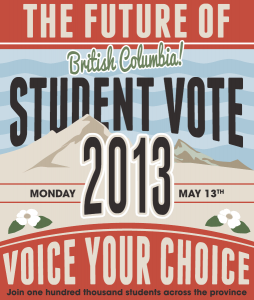 Social Studies 11 is a class taken when students are typically sixteen years old. It is an ideal time to engage students on the history and importance of voting. And this sort of experiential learning, wherein direct experience is inserted into the learning environment, has a rich history of validation since the early work of John Dewey in the 1930s. So giving students the ability to vote at the time they are learning about its importance, and knowing that the earlier a voter casts a first ballot, the more likely they are to be lifelong voter, almost certainly will lead to greater voter participation.
Social Studies 11 is a class taken when students are typically sixteen years old. It is an ideal time to engage students on the history and importance of voting. And this sort of experiential learning, wherein direct experience is inserted into the learning environment, has a rich history of validation since the early work of John Dewey in the 1930s. So giving students the ability to vote at the time they are learning about its importance, and knowing that the earlier a voter casts a first ballot, the more likely they are to be lifelong voter, almost certainly will lead to greater voter participation.
As I noted earlier, today’s decision-makers don’t have to live the long-term consequences of the decisions they make and those who do are either not allowed to or are not participating in our democratic institutions. We can do something about the former by reducing the voter age to 16. After all, the youth of day are the leaders of tomorrow and they should have a say in the direction we are heading as they will inherit what we leave them in the years ahead.
Having spent many years as an educator and having presented to, or engaged in discussions with, high school students and classes across British Columbia on numerous occasions, I find it difficult to accept an argument that students are not mature enough of informed enough at age 16 to vote. Students today have access to information like never before; they are tech savvy and they know where to go to get information if they need it.
And of course, there are numerous other arguments, one of the strongest of which is that many youth work and so pay taxes. Taxation without representation is generally counter to our democratic principles. That is, youth must pay the taxes but they are not allowed to vote for those who put in place laws that create them. Other compelling reasons include the fact that we already trust youth to drive at 16, they can get married at 16 (with parents’ permission) and you can drop out of school at 16. These are all pretty major life responsibilities that are entrusted upon our youth.
What do you think?
So tell me what you think? Should we lower the voter age to 16 in the province of British Columbia? There is a trend happening worldwide in the area. Should we lead the way or not? And if not, why not? If so, why?
Protecting the Constitutional Rights of Francophone Parents in Greater Vancouver
For the past 15 years, the BC government has been unable to provide Francophone children in Vancouver with the quality of education they are constitutionally entitled to. Today in the legislature I questioned the Minister of Education about why that is and when he will relocate the children to a facility that meets their Section 23 rights.
In 2010, a group of Vancouver parents with children attending the Rose-des-vents primary school took the Conseil scolaire francophone de la Colombie-Britannique (CSF) and the provincial government to the BC Supreme Court. They petitioned the court to declare that lack of equivalency between the Rose-des-vents school facilities are those offered to English parents living in the same catchment area constituted a breach of section 23 of the Canadian Charter which guarantees that people whose first language is French, or who have received their schooling in French, have the right to have their children educated in either English or French. The court ruled in their favour but that ruling was subsequently overturned in the BC Court of Appeal by the province.
In an April 2015 Supreme Court of Canada reinstated the BC Supreme Court ruling and declared that a Section 23 infringement had taken place. It was the parents hope that this would bring all parties to the table to find a solution, but the province has continued to fight the rulings. The Province is now seeking a Section 1, “reasonable limits”, justification of a Charter breach.
After 15 years of frustration, parents whose children attend l’école Rose-des-vents are still being forced to send their students to a school with unacceptable conditions despite the Supreme Court of Canada ruling that their charter rights are being infringed upon.
L’école Rose-des-vents was established in 2001 as a temporary primary school that was intended to house 199 students. For the 2015/16 school year there were 357 students enrolled. The school has limited outdoor space, inadequate washroom facilities, classrooms without windows, and has been forced to lease additional facilities from surrounding buildings, including a church basement.
What is particularly frustrating is that parents have gone out of their way to avoid drawing out the process, only wanting to bring all parties to the table to address the infringement of their rights. It is unacceptable that they are still caught in a back and forth between the government and the School Board.
Section 23 of the Canadian Charter of Rights and Freedoms guarantees minority language rights, giving parents who fall under this right the entitlement to have their children taught in an equivalent educational facility to what they could receive in the majority language. Infringements of this right require urgent action on behalf of government. The Supreme Court of Canada Judgments noted that “…for every school year that governments do not meet their obligations under s. 23, that is an increased likelihood of assimilation and cultural erosion”.
In many cases, these children’s french-speaking parents have been recruited for jobs in Vancouver because they are bilingual. They bring a valuable skill-set to the city, but have to fight to have their Francophone children educated in the language they speak at home. The problem is only getting worse.
Francophone student numbers are going up, while enrollment for english-speaking schools in the rest of the city is going down.
In the Conseil scolaire francophone de la Colombie-Britannique (CSF; School District 93) “School District Facilities Plan”, dated November 2015, the board notes that one school is no longer sufficient. There is such a demand for elementary schooling that two catchment areas, each with its own elementary school are now required to ensure that the CSF is offering education that is of equivalent quality to that offered by the Vancouver School Board (School VSB; School District 39) – something they have failed to do for 15 years.
As you will see from the question period exchange reproduce below, while it is encouraging that the Minister of Education’s recognizes the problem, I did not get the sense it is being addressed with the sense of urgency it deserves. Given excess capacity in Vancouver School Board schools, perhaps the Minister can help facilitate timely discussions between the Conseil scolaire francophone and the Vancouver School Board to move decisively to ensure and agreement is developed, and that parents at Rose-des-vents finally see their children taught in a acceptable facility.
We’ve faced similar challenges in Greater Victoria over the last few years. Last year the Victoria School Board leased the recently closed Sundance Elementary to the CSF to meet growing demand. The CSF École Victor-Brodeur, located on the grounds of the old Harbour View Junior Secondary School, also expanded in 2012 into Lampson Street Elementary School that was closed in 2007.
Video of the Exchange
Question
It’s far too long now since parents at l’École Rose-des-vents have been trying to get this government to address their Charter rights to have their children receive a comparable public education in French.
For 15 years now, primary school students have faced unacceptable conditions — a school with a capacity of 199 teaching 357 students, in the 2015-16 school year, classrooms without windows and inadequate washroom facilities, all as part of sharing a program with the secondary school. After years of frustration, francophone parents went to court, arguing that section 23 of the Canadian Charter of Rights and Freedoms was being violated. The Supreme Court of Canada ruled in favour of parents.
Let’s be clear. For the parents, this wasn’t about assigning blame. In fact, their petition to the court specifically avoided the question as to who was to blame. Yet, despite the Supreme Court of Canada ruling, parents still don’t have any answers about when the infringement of their rights will be addressed.
My question to the Minister of Education is this. Surely, this is exactly the type of red tape that this government purports to want to do away with. Why, after over 15 years, has this government not stepped in to ensure that these children are getting the educational experience they are constitutionally entitled to?
Answer
Thank you to the member for Oak Bay–Gordon Head for the question. As I believe he’d be aware, because there is a court case going right now, I’m unable to talk about any of the specifics around that. What I can talk about is our support for school district 93 and for a Conseil scolaire francophone.
When you look around British Columbia right now, there are 290,000 French-speaking people in British Columbia. We have 40 francophone associations. Our French immersion in our school system has increased by 40 percent. I agree with the member opposite that there’s lots that can be done to continue to support the French-speaking students in our school system. We have 53,000 French immersion students in 273 school districts around the province. We also have school district 93, which has school districts right around the province. We continue to work closely with them.
I agree. There are opportunities that we have. We’re going to continue working with them, as we have been within my ministry, for the school, Rose-des-vents, to make sure that they have the best education possible for all students. Every student in British Columbia deserves the same educational opportunities.
Supplementary Question
It’s important to acknowledge that section 23 infringements require urgent action on behalf of the government. The Supreme Court of Canada, in the judgment, stated specifically: “For every school year that the governments do not meet their obligations under section 23, there is an increased likelihood of assimilation and cultural erosion.”
This is especially true in the case of École Rose-des-vents. In November of 2015, in the CSF school district facilities plan, the board notes that one school is no longer sufficient. In fact, francophone elementary schooling is in such demand that two schools are now required.
I don’t think it’s much to ask that after 15 years, parents be given more than just a commitment to study options and work with others. What is the timeline that the minister expects to see children relocated into a facility that meets their section 23 constitutional rights?
Answer
We have two challenges here. We have a school district based mostly in Vancouver that is looking for space. We have the Vancouver school board, which has lots of empty space. I think that we have a great opportunity here to put the two groups together. When you look at the school district, the growing enrolment….
Interjections.
Madame Speaker: Please wait, Minister.
Please continue.
Hon. M. Bernier: As the member opposite pointed out, we do have growing enrolment in CSF. It is one of the areas we do have growing enrolment, while we continue to see declining enrolments in the rest of Vancouver. One of the things that I think that needs to happen — and I will work on this — is making sure that we get that message out there, that we can have these opportunities for the school districts to work together.
If we have empty classrooms and we need those, then let’s start using those classrooms for students and have great education in Vancouver.
Responding to Vancouver School Board budget shortfall
Media statement: March 31, 2016
Andrew Weaver responds to Vancouver School Board budget shortfall
For Immediate Release
Victoria B.C. – Today Andrew Weaver, Leader of the B.C. Green Party and MLA for Oak Bay-Gordon Head, commented on the Vancouver School Board’s budgetary shortfall and the challenges facing public schools around the province.
Yesterday Premier Clark told the CBC’s Audrey McKinnon that the province can help BC’s public school system by growing the economy and attracting more people to live here.
“Fundamentally the BC Liberal’s have it backwards. A quality education is not the luxury of a strong economy. A quality public education system is what builds a strong economy”, Weaver noted. “The Premier has all these hypothetical conditions about a growing economy that she thinks must be met before her government will adequately fund public schools. This is short-sighted and puts our province’s economic future in jeopardy.”
“This budgetary problem has its roots in the Liberal’s 2002 shift from block funding to per-student funding, of which we have the second lowest rate in the country. The change was brought in when Christy Clark was the Minister of Education from 2001 to 2004.”
“The situation in Vancouver is further compounded by the BC Liberals’ irresponsible economic policies that have made affordability a huge issue in this city. People cannot afford to raise families here. The government cannot wait for other people to move in and solve the problem – they need to step up at support the school board.”
– 30 –
Media Contact
Mat Wright – Press Secretary Andrew Weaver MLA
1 250 216 3382
mat.wright@leg.bc.ca


